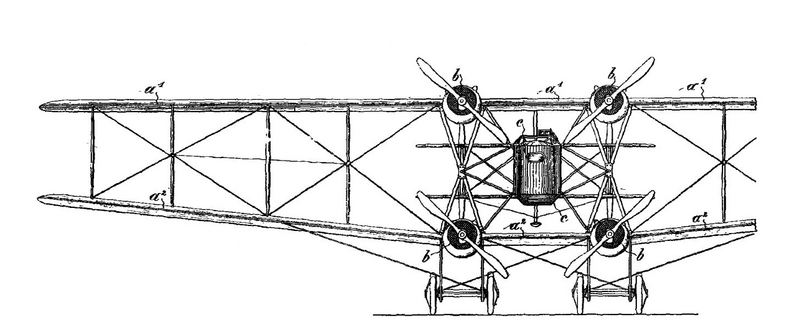When I picked up this small photo of a large monstrosity, there were two things that I realized right away: the print was damaged, and I had no clue what plane it showed. My friend and photo restoration artist Bob Cohen took a stab at it, and took care of both problems...so below is the restored image, and he was able to come up with an identity, a Blériot 74 (or in Blériot's parlance, an LXXIV)...or is it?
After doing some more checking, it turns out that this is one of those murky corners of aviation history where things don't always make a lot of sense, and there are a whole lot of places on the internet where not a lot of care has gone into accuracy in image captions. Here's some of what I found in digging into this little mystery.
First, Frenchman Louis Blériot was the fellow who invented the first practical automobile headlamp. With that invention bringing a nice steady flow of cash, he could delve into his
real passion, aeroplanes. In 1909, he hit the jackpot (in fame at least), and developed the world's first successful monoplane, the Type XI, and then used it to become the first person to fly across the English Channel, claiming the
Daily Mail's £1,000 prize. His company produced around 900 airplanes, most of them based on the type XI. He later came to head a consortium called the Société pour les Appareils Deperdussin, which he renamed Société Pour L'Aviation et ses Dérivés, better known by its acronym SPAD.
At some point during WWI, Blériot started thinking big, really big. Bomber big. The results of this thinking took the form of five large one-off aircraft, the Type 67, 71, 73, 74 and 75. The first four were intended to be large, long-range bombers, and the last was to be an airliner variant based on the airliners. None of these planes were successful by any means. One of these planes is shown in the photo above, but figuring out which has proved to be harder than I expected, so I'll run through them here.

The first, the Type 67, is the one that, structurally, most resembles the plane in our photo, with a fuselage suspended between both wings. However, the Type 67 used Gnome rotary engines, and flew only once, on September 18, 1916, crashing at the end of the flight. By now, you've probably noticed the "67" written by hand in the lower right corner of our photo. Was this an indication of the subject, or just a negative number (which would be an odd coincidence)? The issue is, of course, that this photo clearly doesn't show the plane to be powered by rotary engines. Maybe Blériot started out with inline Hispano-Suizas and then changed his mind? Then I found this patent drawing of the Type 67 on a Russian web page called
Their Flying Machines. While photos of the 67 clearly show Gnome radials (
this one, for instance), the drawing shows the smaller cowlings that were used over the in-line engines shown in our photo.
Blériot's next attempt was the slightly larger Type 71 which debuted in November 1917, but the
patent drawing for this one (which comes from
this Blériot page on the Arizona Model Aircrafter's website) shows a fuselage, though similar in shape to the 67, now mounted directly on the lower wing.
The Type 73, an even stranger aircraft, followed in 1918, but was destroyed when it broke up in-flight on January 22, 1919. Here's
its patent drawing...clearly not our bird. A second Type 73 had been started, but after the crash of the first one, that attempt was abandoned, and the wings, which had already been built, were used on the Type 74,
a whale of a plane. And then there was the 75, the
airliner version. Thankfully it was also abandoned.
So, for our photo, my money is on the Type 67, which at one point or another was equipped with different engines than it eventually flew with. Have a different thought or opinion? I'd love to hear from you via the comments section below.












